
Бесплатный фрагмент - All sciences. №1, 2023
International Scientific Journal
DEDICATED TO THE GREAT GENIUS NIKOLA TESLA
UDC 929.5
Nikola Tesla is a Serbian-American engineer and physicist, inventor in the field of electrical and radio engineering. He is a Serb by nationality, was born in the Austrian Empire, grew up in Austria-Hungary, and in subsequent years mainly worked in France and the USA. In 1891, he received US citizenship. He is widely known for his contribution to the creation of devices operating on alternating current, multiphase systems, a synchronous generator and an asynchronous electric motor, which made it possible to make the so-called second stage of the industrial revolution. He is also known as a proponent of the theory of the existence of ether — thanks to his numerous experiments and experiments aimed at showing the presence of ether as a special form of matter that can be used in technology.
The unit of measurement of magnetic flux density (magnetic induction) is named after the inventor — Tesla. Among the many awards are the medals of Elliot Cresson, John Scott, Thomas Edison. Contemporary biographers call Tesla "the man who invented the XX century" and the "holy intercessor" of modern electricity. After demonstrating the radio and winning the "War of Currents", Tesla received widespread recognition as an outstanding electrical engineer and inventor. Tesla's early work paved the way for modern electrical engineering, and his discoveries of the early period had innovative significance. In the USA, Tesla's fame could compete with any inventor or scientist in history, as well as in popular culture.
Tesla's family lived in the village of Smilyan, 6 km from the town of Gospich, the main city of the historical province of Lika, which was part of the Austrian Empire at that time. Father — Milutin Tesla (1819-1879), priest of the Srem Diocese of the Serbian Orthodox Church, Serb. Mother — Georgina (Juka) Tesla (1822-1892), nee Mandich, was the daughter of a priest. On July 10, 1856, a fourth child appeared in the family — Nikola. In total there were five children in the family: three daughters — Milka, Angelina and Maritza and two sons — Nikola and his older brother Dan. When Nikola was five years old, his brother died after falling from a horse.
Nikola graduated from the first grade of primary school in Smilany. In 1862, shortly after the death of Dana, the father of the family was promoted, and the Tesla family moved to Gospić, where Nikola completed the remaining three grades of elementary school, and then the three-year lower real gymnasium, which he graduated in 1870. In the autumn of the same year, Nikola entered the Higher Real School in the city of Karlovac. He lived in the house of his aunt, his father's cousin, Stanki Baranovich. In July 1873, Nikola received his matriculation certificate. Despite his father's order, he returned to his family in Gospic, where there was a cholera epidemic, and immediately became infected. Here 's what Tesla himself told about it:
"The path of a priest was destined for me from childhood. This prospect hung over me like a black cloud. Having received my matriculation certificate, I found myself at a crossroads. Should I disobey my father, ignore my mother's loving wishes, or submit to fate? This thought oppressed me, and I looked into the future with fear. I deeply respected my parents, so I decided to study spiritual sciences. It was then that a terrible cholera epidemic broke out, which mowed down a tenth of the population. Contrary to my father's orders, which did not allow for objections, I rushed home, and the disease knocked me down. Later, cholera led to dropsy, lung problems and other diseases. Nine months in bed, almost without movement, seemed to have exhausted all my vitality, and the doctors abandoned me. It was a painful experience not so much because of physical suffering, but because of my great desire to live. During one of the attacks, when everyone thought I was dying, my father rushed into the room to support me with these words: "You will recover." I can still see his deathly pale face when he tried to encourage me in a tone that contradicted his assurances. "Maybe," I replied, "I will be able to get better if you let me study engineering." "You will enter the best educational institution in Europe," he replied solemnly, and I realized that he would do it. A heavy load was lifted from my soul. But the consolation might have come too late if I hadn't been miraculously cured by an old woman with a decoction of beans. There was no power of suggestion or mysterious influence in this. The remedy for the disease was in the full sense curative, heroic, if not desperate, but it had an effect."
The recovered Nikola Tesla was soon to be called up for three years of service in the Austro-Hungarian Army. His relatives considered him not healthy enough and hid him in the mountains. He returned back only in the early summer of 1875.
In the same year, Nikola entered the Higher Technical School in Graz (now the Graz Technical University), where he began to study electrical engineering. Observing the work of the Gram machine at lectures on electrical engineering, Tesla came to the idea of the imperfection of DC machines, however, Professor Yakov Peshl sharply criticized his ideas, giving a lecture before the entire course on the impracticability of using alternating current in electric motors. In his third year, Tesla became interested in gambling, losing large amounts of money at cards. In his memoirs, Tesla wrote that he was driven "not only by the desire to have fun, but also by failures in achieving the intended goal." He always distributed winnings to losers, for which he soon became known as an eccentric. In the end, he lost so badly that his mother had to borrow from her friend. He has never played since. On April 17 (29), 1879, Nikola's father died.
Tesla got a job as a teacher at a real gymnasium in Gospić, the one in which he studied. He was not satisfied with the work in Gospich. The family had little money, and only thanks to financial assistance from his two uncles, Petar and Pavel Mandich, the young Tesla was able to leave for Prague in January 1880, where he entered the Faculty of Philosophy at Prague University. He studied for only one semester and was forced to look for a job.
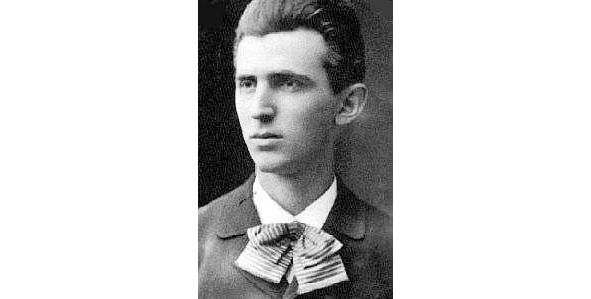
Until 1882, Tesla worked as an electrical engineer at the government telegraph company in Budapest, which at that time was engaged in conducting telephone lines and building a central telephone exchange. In February 1882, Tesla came up with a way to use a phenomenon in an electric motor, which later became known as a rotating magnetic field.
Working in a telegraph company prevented Tesla from carrying out his plans to create an alternating current electric motor. At the end of 1882, he got a job at the Continental Edison Company in Paris. One of the largest works of the company was the construction of a power plant for the railway station in Strasbourg. At the beginning of 1883, the company sent Nicola to Strasbourg to solve a number of work problems that had arisen during the installation of lighting equipment at the new railway station. In his spare time, Tesla worked on making a model of an asynchronous electric motor. In 1883, the operation of the engine was demonstrated at the Strasbourg City Hall.
By the spring of 1884, the work at the Strasbourg railway station was completed, and Tesla returned to Paris, expecting a bonus of 25 thousand dollars from the company. After trying to get the bonuses due to him, he realized that he could not see this money and, offended, resigned. One of the Soviet biographers of the inventor, B. N. Rzonsnitsky, claims that Tesla was thinking about moving to Russia, but one of the administrators of the Continental Company, Charles Bechlor, persuaded Tesla to go to the USA. Bechlor wrote a letter of recommendation to his friend Thomas Edison:
«It would be an unforgivable mistake to allow such a talent to leave for Russia. You will still be grateful to me, Mr. Edison, for the fact that I did not spare a few hours to convince this young man to give up the idea of going to Petersburg. I know two great people — one of them is you, the other is this young man.»
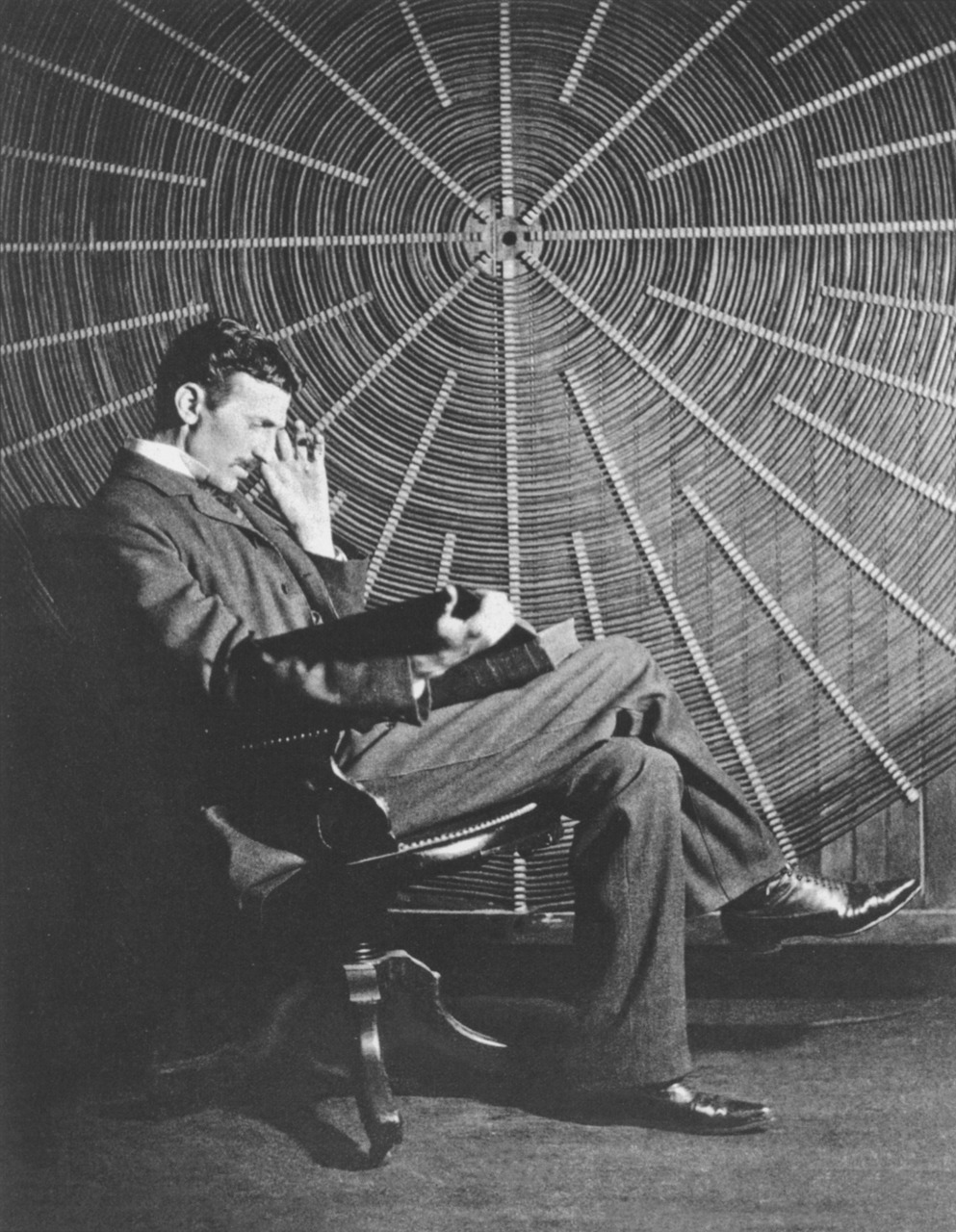
On July 6, 1884, Tesla arrived in New York. He got a job at Thomas Edison's company (Edison Machine Works) as an engineer for the repair of electric motors and DC generators.
On each material, gentlemen, there is a certain charge, both positive and negative, when they are together, then any object is neutral, but it is only necessary to excite these charges by moving the wire between the magnets, as a current appears in it, which is excited by these magnets. This phenomenon, called electromagnetic induction, when a current arises in a wire due to movement, was discovered by Michael Faraday. If the magnets are in the form of a torus, one of them is smaller, and the second is larger, and if you move the wire between them in a circle in only one direction, then you get a separation of charges into positive and negative, which can be accumulated on capacitors, which are only large metal plates that retain a charge. Of course, direct current is safer, it is easy to work with motors, it is easier to save it, but all these positive aspects are outweighed by one huge drawback — the difficulty of transportation.
Electric current is the movement of free charged particles, electrons between atoms in a directed way, and not chaotically, as it happens in thermal motion. And if the electrons move only in one direction, then they encounter a large number of collisions and quickly lose their energy, so for each enterprise there was a need to create its own power plant, because the maximum DC transmission length is no more than a mile, and already at longer distances the current dropped almost to zero.
Speaking of alternating current, there is already the case with whole coils, when rotating them in one direction, the magnetic fields were not always directed correctly, if they were directed in one direction to one plate, then the direction changed on the next turn. That is, if the current went from left to right, then in the next period, it went from right to left. The electrons did not have time to make such a long journey and only oscillated, while not losing energy, but, of course, transporting it. In such a current, positive and negative polarities change with a certain frequency and losses in such a system are minimal, which allows you to transmit alternating current over simply huge distances.
That was one of Tesla's million ideas. Edison, on the other hand, rather coldly perceived Tesla's new ideas and more and more openly expressed disapproval of the direction of the inventor's personal research. In the spring of 1885, Edison promised Tesla $ 50,000 if he could constructively improve the DC electric machines invented by Edison. Nikola actively set to work and soon introduced 24 varieties of Edison machines, a new switchboard and regulator, significantly improving operational characteristics. Having approved all the improvements, in response to a question about remuneration, Edison refused Tesla, noting that the immigrant still does not understand American humor well. Offended, Tesla immediately quit.
After working for only a year at Edison's company, Tesla gained fame in engineering circles. After learning about his dismissal, a group of electrical engineers offered Nikola to organize his own company related to electric lighting issues. Tesla's projects on the use of alternating current did not inspire them, and then they changed the original proposal, limiting themselves to a proposal to develop an arc lamp project for street lighting. A year later, the project was ready. Instead of money, entrepreneurs offered the inventor a part of the shares of the company created to operate the new lamp. This option did not suit the inventor, the company in response tried to get rid of him, trying to slander and defame Tesla.
In 1886, from autumn to spring, the inventor had to survive on auxiliary work. He was engaged in digging ditches, "slept where he had to, and ate what he found." During this period, he became friends with engineer Brown, who was in a similar position, who was able to persuade several of his acquaintances to provide financial support to Tesla. In April 1887, the Tesla Electric Company, created with this money, began to arrange street lighting with new arc lamps. Soon the company's prospects were proved by large orders from many US cities. For the inventor himself, the company was only a means to achieve a cherished goal. For the office of his company in New York, Tesla rented a house on Fifth Avenue near the building occupied by Edison's company. An acute competitive struggle, known as the "War of Currents", was unleashed between the two companies.
In July 1888, the famous American industrialist George Westinghouse bought more than 40 patents from Tesla, paying an average of $ 25,000 for each and a dollar for each horsepower issued by his generators. After that, he thanked his friend Brown by giving him half of the million dollars he received.
So the work continued, but there were also clashes with Edison, also at the trials. Also, due to Edison's merit, a new type of execution was introduced — in the electric chair, using alternating current. Large-scale executions of animals on alternating current, including Topsy the elephant, were also carried out to demonstrate the dangers of alternating and direct current safety. Westinghouse was against all these measures, he even hired a lawyer for Kemler, the first convict and subsequently executed in the electric chair. But even so, the work of victory followed victory and alternating current spread more and more, entering the life of modern cities.
Westinghouse also invited the inventor to become a consultant at the plants in Pittsburgh, where industrial designs of alternating current machines were being developed. The work did not bring satisfaction to the inventor, preventing the emergence of new ideas. Despite Westinghouse's persuasions, a year later Tesla returned to his laboratory in New York. Shortly after returning from Pittsburgh, Nikola Tesla traveled to Europe, where he visited the Paris World's Fair in 1889 and visited his mother and sister Maritza.
But one day, Westinghouse investors reminded him of the need to pay a dollar for each horsepower issued by generators, but the number of generators increased so much that it was necessary to give Tesla $ 12 million and although this would make him one of the richest people in the states, George would be ruined, so Nikola Tesla broke the contract without any additional conditions. So time passed and finally, in the end, Edison himself began to produce alternators. It was a victory.
In 1888-1895, Tesla was engaged in research of high-frequency magnetic fields. These years were the most fruitful: he received many patents for inventions. The leadership of the American Institute of Electrical Engineers invited Tesla to give a lecture about his work. On May 20, 1892, he spoke to the outstanding electrical engineers of that time and was a great success. There he demonstrated a large number of his experiments, he lit light bulbs by introducing them into an alternating electromagnetic field. He demonstrated how to transmit electricity without wires, controlled lightning and with the help of his hands passed a voltage of millions of volts through his body. It was a huge success, he was given an ovation and for the first time called a man from the future.
After that lecture, Tesla was shown the chair of Faraday himself, offering to take it and noting that after his death no one was worthy of such an honor, and then treated to whiskey from his cherished bottle. On March 13, 1895, a fire broke out in the Fifth Avenue laboratory. The building burned to the ground, destroying the inventor's latest achievements: a mechanical oscillator, a test stand for new lamps for electric lighting, a mock-up of a device for wireless transmission of messages over long distances and an installation for studying the nature of electricity. Tesla himself said that he could reconstruct all his discoveries from memory.
Financial assistance to the inventor was provided by the Niagara Falls Company. Thanks to Edward Adams, Tesla had $100,000 to equip a new laboratory. Already in the fall, the research resumed at a new address: 46 Houston Street. At the end of 1896, Tesla achieved the transmission of a radio signal over a distance of 30 miles (48 km).
It was there that a mechanical oscillator using selective resonance was created, representing a kind of analogue of a swing, if you give a push at the right moment, you can rock the installation to large amplitudes without putting much effort. It was then that an artificial earthquake was caused, as a result of one of the experiments that could destroy the Brooklyn Bridge in a few minutes. Selective resonance is the action of constant uniform vibrations that can destroy any object of choice. This earthquake was called the New York earthquake of 1898.
It is also worth noting the great predilection of Nikola Tesla himself for pigeons. But also the inventor himself organized small celebrations, where the notable people of that time came, Kipling, who loved to read poetry, Mark Twain made them laugh with his signature stories, and Dvorzek played the piano, and then Tesla brought them to his laboratory, showing wonderful experiments, telling about the future of science. It was an unforgettable evening. Nikola met many of them because of contact with Robert Johnson, the editor-in-chief of Century Magazine, with whom they met on the basis of love for poetry, and once they also translated and published a collection of poems by Serbian poets. They were also impressed by one of them — Ioan Zmai.
One of Tesla ’s favorite poems was:
"An honest man will not buy gold,
An honest man will not yield
to honor — He needs honor like light.
Glad to sell it dishonest,
But as everyone knows,
The dishonest have no honor.»
«Честный золота не купит,
Честный чести не уступит —
Честь нужна ему как свет.
Рад продать его бесчестный,
Но как всякому известно,
У бесчестных чести нет».
Moreover, the news is known today that it was Tesla who dissuaded Johnson from boarding the train that was in an accident. For example, he also persuaded his friend and patron, the owner of the Waldorf-Astoria hotel chain, Colonel John Jacob Astaire, not to sail on the Titanic, but, unfortunately, he did not listen to him.
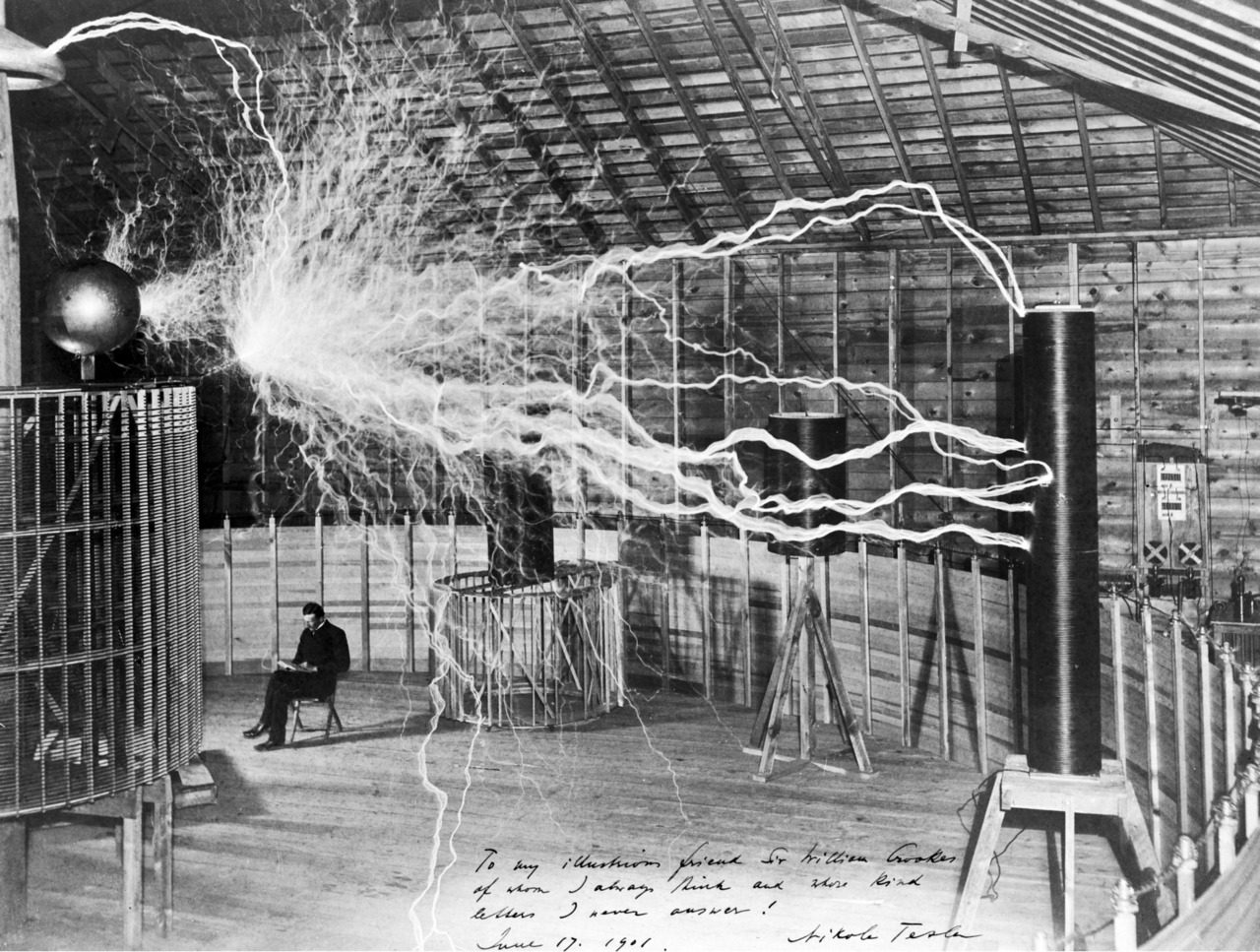
According to Tesla's assumption, standing waves from Colorado Springs reached the greatest intensity near Amsterdam Island in the Indian Ocean. On May 18, 1899, at the invitation of a local electric company, Tesla moved to the resort town of Colorado Springs, where he stayed for almost a year, and about $ 30,000 was allocated as a grant from Colonel Astaire for his research. He stayed at the Alta Vista Hotel, where he placed his office.
On June 2, 1899, Tesla completed the construction of a wooden hangar measuring approximately 50 by 60 feet (15 by 18 meters), about 18 feet high (5.4 meters), with two windows and a large door. At the end of July, Tesla was already conducting various experiments in complete secrecy, not allowing anyone but his assistants into his laboratory. He conducted experiments mainly at night due to the availability of electrical energy, which he received from the city electric company.
While working in his laboratory, Tesla developed the design of a large high-frequency emitter with three oscillatory circuits, the potential of which reached 10 million volts, tested various variants of receiving devices with one or two coherers with special offset excitation circuits, measured electromagnetic radiation of electric discharges in nature, developed measuring techniques in radio engineering, thought out modulator devices, antennas with parallel power supply, etc. He also outlined his theory of the formation of ball lightning and could create them artificially.
Nikola Tesla recorded descriptions of scientific research and observations in the laboratory in Colorado Springs in a diary, which was later published under the title "Colorado Springs Notes, 1899-1900". Judging by the entries in his diary, Tesla devoted most of his time (about 56%) to the transmitting device, in particular to the generator of high-frequency currents of high power, then to receivers of weak signals (about 21%), measuring the capacity of a vertical single-pole antenna (about 16%), and various other scientific research and research (about 6%).
There were also rumors about the recording "Abandon hope, everyone who enters here", at the entrance to the laboratory. In the middle of the laboratory, a transformer was created, one end of which was grounded, and the second was brought to a great height. This device was capable of accumulating the energy of lightning discharges and giving out another several million volts and a frequency of 150,000 Hz, but of course I wanted more. The goal was to transmit energy over long distances using the Earth as a transmitter. Not far from the laboratory, he stuck several hundred light bulbs into the Ground and began to expect a thunderstorm, and as soon as lightning struck the ball at the top of the mast, the laboratory came to life. The transformer collected the energy of the lightning discharge and threw it into the atmosphere with triple force! These were 40-meter man-made lightning bolts! The flow of energy covered the city, everything was saturated with electricity, the experiment was fully justified, it became possible to transmit energy wirelessly through the ground, 250 meters from the tower, two hundred light bulbs lit up at once. But, unfortunately, the generator of the local power plant completely burned down. And after completing the entire research program, he put everything on paper, after which Robert Johnson published an article in his own journal.
It was then that this article caught the eye of the famous banker and industrialist John Pierpont Morgan, and he decided to meet with him, but he was only interested in using radio communication. So on January 11, 1900, Tesla returned to New York. The Tesla Tower is Nikola Tesla's first wireless telecommunications tower for commercial transatlantic telephony, radio broadcasting and demonstration of wireless power transmission. The first full-scale tests of the resonator tower took place on June 15, 1903 at exactly midnight local time. According to his plan, he wanted to create 5 towers for wireless communication around the globe, "as soon as the project is completed, a business person can dictate his instructions from New York, and they will immediately appear in the office in London or any other place. An inexpensive instrument, no more than a watch, will allow its owner to listen anywhere, at sea or on Land, to music or songs, speeches of a political leader, a speech by an outstanding scientist or sermons of a priest located at a great distance. In the same way, any picture, sign, drawing or text can be transmitted," Tesla said.
With the help of his project, he wants not only to transmit energy across the planet without wires, but with the help of this system, he intends to cause rains in the desert, illuminate the sky over sea routes, power cars and airplanes, and even carry out interplanetary communications. Of course, such a project required a much larger scope than Morgan singled out, but this does not bother him, and he creates on the island of Long Island, 60 meters from New York, he creates the first tower by the name of the Wardencliff locality. With the unfinished tower, he begins fantastic experiments. In the summer of 1903, the tower on Long Island almost drives New Yorkers crazy, giant artificial lightning bolts stretch for hundreds of miles in all directions from it. They light up the sky over the Atlantic so that you can read the newspaper headlines that the newspaper "New York San" writes: "Last night we witnessed strange phenomena — giant lightning, personally emitted by Tesla. The layers of the atmosphere ignited at different heights and over a large area so that the night instantly turned into day, the whole air was filled with glow. It centered around the edges of the human body, and everyone present radiated a light blue mystical flame. We felt like ghosts to ourselves." As Tesla himself wrote: "The waves created by my transmitter will be the greatest spontaneous manifestation of energy on the planet."
The halo surrounding Tesla's personality and discoveries contributed to the spread of all kinds of statements, which are usually semi-mythical in nature. Such statements cannot be verified due to the lack of documents, which does not prevent, however, attributing to Tesla a direct or indirect relation to many mysteries of the XX century.
According to legend, after Tesla's death, the FBI special department, which was engaged in storing the property of foreign citizens (Eng. Alien Property Custodian), sent employees who seized all the papers they found in the room. The FBI suspected that even a few years before Tesla's death, some papers had been stolen by German intelligence and could be used to create German flying saucers. Wanting to prevent a repeat of this incident, the FBI classified all the papers they found.
The book by writer Tim Schwartz mentions that in other hotels where Tesla rented rooms, his personal belongings also remained. Some of them are lost, more than 12 boxes of things were sold to pay Tesla's bills. Tim Schwartz also claims that in 1976, four nondescript boxes of papers were auctioned by a certain Michael P. Bornes, a bookseller from Manhattan. Dale Alfrey bought them for $25, not knowing what kind of papers they were. According to the author of the book, it later turned out that these were Nikola Tesla's laboratory journals and papers, which described hostile alien creatures capable of controlling the human brain.
Many readers have questioned Tim Schwartz's claims, perceiving the book as an attempt to create a sensation. It is hardly possible to talk about Tesla's direct participation in the hypothetical event of the "Philodelfi experiment" due to the discrepancy between the dates of Tesla's life and the time of the alleged experiment, since Tesla himself died before it began — on January 7, 1943, while it is assumed that the experiment was conducted only on October 28, 1943.
In 1931, Nikola Tesla allegedly demonstrated a working prototype of an electric car moving without any traditional current sources. There is no material evidence of the existence of this electric car.
The American agency DARPA in 1958 allegedly tried to create Tesla's legendary "death rays" during the Seesaw project, which was conducted at the Livermore National Laboratory. In 1982, the project was interrupted due to a number of failures and budget overruns.
At the end of the XX — beginning of the XXI century, a hypothesis appeared about the connection of Nikola Tesla with the Tunguska meteorite. According to this hypothesis, on the day of the observation of the Tunguska phenomenon (June 30, 1908), Nikola Tesla conducted an experiment on the transmission of energy «through the air». A few months before the explosion, Tesla claimed that he would be able to light the way to the North Pole of the expedition of the famous traveler Robert Peary. In addition, there are records in the journal of the Library of Congress that he requested maps of «the least populated parts of Siberia.» His experiments on the creation of standing waves, when, as it is claimed, a powerful electric pulse was concentrated tens of thousands of kilometers away in the Indian Ocean, quite fit into this «hypothesis». If Tesla managed to pump an impulse with the energy of the so-called «ether» (a hypothetical medium, to which, according to scientific ideas of the past centuries, the role of a carrier of electromagnetic interactions was attributed) and the resonance effect to «rock» the wave, then, according to this assumption, a discharge with a power comparable to a nuclear explosion should have occurred.

In total, Tesla has more than 700 inventions and patents, some of which are the most important historical milestones of modern electricity. Tesla probably invented radio before Marconi and Popov, and also worked with X-rays before their official discovery by Wilhelm Roentgen.
Working for Westinghouse, he patented the use of multiphase alternating current systems. Before the invention of the asynchronous (induction) motor, alternating current was not widely used, since it could not be used in pre-existing electric motors. Since 1889, Nikola Tesla began to study high-frequency currents and high voltages. He invented the first samples of electromechanical HF generators (including inductor type) and a high—frequency transformer (Tesla transformer, 1891), thereby creating prerequisites for the development of a new branch of electrical engineering - HF technology.
In the course of research on high-frequency currents, Tesla also paid attention to safety issues. Experimenting on his body, he studied the effect of alternating currents of various frequencies and strengths on the human body. Many of the rules first developed by Tesla have become part of the modern fundamentals of safety when working with RF currents. He found that at a current frequency of over 700 Hz, an electric current flows over the surface of the body without harming the tissues of the body. Electrical devices developed by Tesla for medical research have become widespread in the world.
Experiments with high-frequency high-voltage currents led the inventor to discover a method for cleaning contaminated surfaces. A similar effect of currents on the skin showed that in this way it is possible to remove small rashes, clean pores and kill germs. This method is used in modern electrotherapy.
On October 12, 1887, Tesla gave a rigorous scientific description of the essence of the phenomenon of a rotating magnetic field. On May 1, 1888, Tesla received his main patents for the invention of multiphase electric machines (including an asynchronous electric motor) and a system for transmitting electricity by means of a multiphase alternating current. Using a two-phase system, which he considered the most economical, a number of industrial electrical installations were put into operation in the USA, including the Niagara Hydroelectric Power Station (1895), the largest in those years.
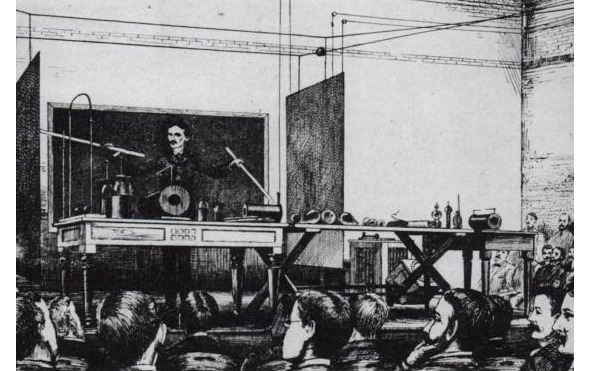
In 1891, at a public lecture, Tesla described and demonstrated the principles of radio communication. Tesla was one of the first to patent a method for reliably obtaining currents that can be used in radio communications. U.S. Patent 447,920, issued in the United States on March 10, 1891, described the "Method of Operating Arc Lamps" ("Method of Operating Arc-Lamps"), in which an alternating current generator produced high-frequency (by the standards of that time) current fluctuations of the order of 10,000 Hz. A patented innovation was the method of suppressing the sound produced by an arc lamp under the influence of alternating or pulsating current, for which Tesla came up with the idea of using frequencies that are beyond the perception of human hearing. According to the modern classification, the alternator operated in the range of very low radio frequencies.
In 1893, the scientist took up the issues of wireless communication and invented a mast antenna.
Nikola Tesla Awards:
1. Knight of the Montenegrin Order of Prince Danilo I, 2nd degree (1895).
2. Knight of the Grand Cross of the Order of the White Lion (Czechoslovakia) (1891),
3. Elliot Cresson Medal (1894),
4. Edison Medal (AIEE, 1916),
5. John Scott Medal (1934)
Tesla's name is very popular today. The unit of measurement of magnetic induction in the international system of SI units is named after Tesla. The airport in the Belgrade suburb of Surcin is named after Nikola Tesla. In Croatia, in the resort town of Porec (horv. Poreč), located on the western coast of the Istrian peninsula, there is an embankment named after Nikola Tesla. Streets in Zagreb, Sibenik, Split, Rijeka, Varazdin, Budva (Montenegro), Moscow (IC "Skolkovo"), Yekaterinburg, Teremakh, Lozhka, Astana, Minsk are named after Tesla. Monuments to Tesla are installed near the University of Belgrade, Belgrade International Airport, the Church of the Resurrection of Christ in Podgorica, as well as in the cities of New York (USA), Niagara Falls (USA), Prague (Czech Republic), Cheboksary (Russia), the capital of Azerbaijan — Baku. In Cheboksary, on Ivan Yakovlev Avenue, there is a square named after N. Tesla. There is also the only monument to the inventor in Russia.
In 1970, the International Astronomical Union named a crater on the far side of the moon after Tesla. The asteroid (2244) is named after him Tesla. Thanks to a grant allocated by 2020 ($750,000), the Tesla Research Center in Wardencliff (New York, USA) will turn one laboratory into a museum of Tesla and his legacy, as well as an educational and research center; at the same time, a corresponding program in the field of entrepreneurship and technology will be created.
In the fall of 1937, in New York, 81-year-old Tesla left the New Yorker Hotel to feed the pigeons at the cathedral and library, as usual. Crossing the street a couple of blocks from the hotel, Tesla could not dodge a moving taxi and fell, suffering a back injury and a fracture of three ribs. Tesla refused the services of a doctor, which he followed before, and never fully recovered. The incident caused acute pneumonia, which turned into a chronic form. Tesla was bedridden for several months and was able to get up again in early 1938.
A war has begun in Europe. Tesla was deeply worried about his homeland, which was under occupation, repeatedly making fervent appeals for peace to all Slavs (in 1943, after his death, the first Guards Division of the People's Liberation Army of Yugoslavia was named Nikola Tesla for his courage and heroism). On January 1, 1943, Eleanor Roosevelt, the wife of the US president, expressed a wish to visit a sick Tesla. Tesla's nephew Sava Kosanovich visited him on January 5 and arranged a meeting. He was the last person to communicate with Tesla.
Nikola Tesla died in his New Yorker Hotel room on the night of January 7-8, 1943, at the 87th year of his life. The body was discovered on January 8 by the maid Alice Monahan, who entered the room despite the "do not disturb" sign posted by Tesla on January 5. According to the coroner's report, death occurred around 22:30 at night, presumably from coronary thrombosis. On January 12, the body was cremated, and the urn with the ashes was installed at Ferncliffe Cemetery in New York. In 1957, it was moved to the Nikola Tesla Museum in Belgrade.
Aliyev I. X.
CEO of OOO «Electron Laboratory»,
President of the Electron Scientific School
PHYSICAL AND MATHEMATICAL SCIENCES
CO2 GAS CONCENTRATION MONITORING DEVICE
UDC 620.191
Qo’ldashov Obbozjon Xakimovich
Doctor of Technical Sciences, Professor of the Scientific Research Institute "Physics of Semiconductors and Microelectronics" at the National University of Uzbekistan
Bekchanov Ulug’bek Qo’ziboy o’g’li
2nd year Master of the Department of "Physics of Semiconductors and Polymers" of the Faculty of Physics of the Mirzo Ulugbek National University of Uzbekistan
Scientific Research Institute «Physics of Semiconductors and Microelectronics» at the National University of Uzbekistan
Annotation. The article discusses the principles of constructing an optoelectronic device for monitoring the concentration of CO2 gases. Intense absorption lines of CO2 gases have been determined. The optoelectronic device uses LEDs based on GaAlAsSb/GaInAsSb/GaAlAsSb (3.12 microns) as the emitting diode at the reference wavelength, and LEDs based on GaAlAsSb/GaInAsSb/GaAlAsSb (3.39 microns) as the emitting diode at the measuring wavelength.
Keywords: gas analyzer, carbon dioxide, control, flowchart, time diagrams.
Аннотация. В статье рассматриваются принципы построения оптоэлектронного устройства для контроля концентрации CO2 газов. Определены интенсивные линии поглощения CO2 газов. В оптоэлектронном устройстве использованы в качестве излучающего диода на опорной длине волне светодиоды на основе GaAlAsSb/GaInAsSb/ GaAlAsSb (3.12 мкм), а излучающего диода на измерительной длине волны светодиоды на основе GaAlAsSb/GaInAsSb/GaAlAsSb (3.39 мкм).
Ключевые слова: газоанализатор, углекислые газы, контроль, блок схема, временные диаграммы.
In recent years, more and more attention has been attracted to the problems of using clean unconventional renewable energy sources (NVE) for the needs of energy supply to various agricultural and industrial facilities. The relevance and prospects of this energy sector are due to two main factors: the catastrophically difficult situation of the environment and the need to search for new types of energy.
The successes achieved in the creation of wind, solar and a number of other types of unconventional power plants are widely covered in various works, recently much attention has been paid to geothermal energy. The prospects for using the Earth's heat energy are truly limitless, because under the surface of our planet, which is a giant natural energy boiler, huge reserves of heat and energy are concentrated.
Today, geothermal energy is actively developing in Uzbekistan. On the territory of Uzbekistan, forecast geothermal resources at accessible depths (up to 5-6 km) are 4-6 times higher than hydrocarbon resources. The main consumers of geothermal resources in the near and long term in Uzbekistan will undoubtedly be heat supply and, to a much lesser extent, electricity generation.
By absolute value, of all types of renewable energy, the subsoil of Uzbekistan has the greatest integral energy potential in the form of heat from dry rocks (petrothermal resources) and large basins with hydrothermal waters.
Geothermal waters are available in all regions of Uzbekistan. Long-term surveys have allowed to identify 8 large basins with hydrothermal resources on its territory. The gross potential of geothermal waters is estimated at 171 thousand tons. However, the technical potential of geothermal sources has not yet been determined. The Fergana Valley and Bukhara Viloyat have the greatest potential of geothermal waters. The average temperature of geothermal waters in the republic is 45.5 °C, the warmest waters are in Bukhara (56 °C) and Syrdarya (50 °C) viloyats. It should be noted that the practical realization of the energy of geothermal waters is associated with the development of appropriate environmental measures due to their chemical composition. Petrothermal energy resources in the form of dry rocks with temperatures from 45 to 300 °C have also been identified in the country. The realization of the potential of petrothermal energy (heat of dry rocks, granitoids) can be carried out using power plants on low-boiling working bodies with a block capacity of 40 MW on the basis of the Chust-Adrasman petrothermal anomaly in the Fergana Valley [1].
The main advantage of geothermal energy is its practical inexhaustibility and complete independence from environmental conditions, time of day and year [2-3]. Geothermal energy owes its "design" to the red-hot central core of the Earth, with a huge supply of thermal energy. Only in the upper three-kilometer layer of the Earth is stored the amount of thermal energy equivalent to the energy of about 300 billion tons of coal [4].
Figure 1 shows a diagram of the use of geothermal resources.
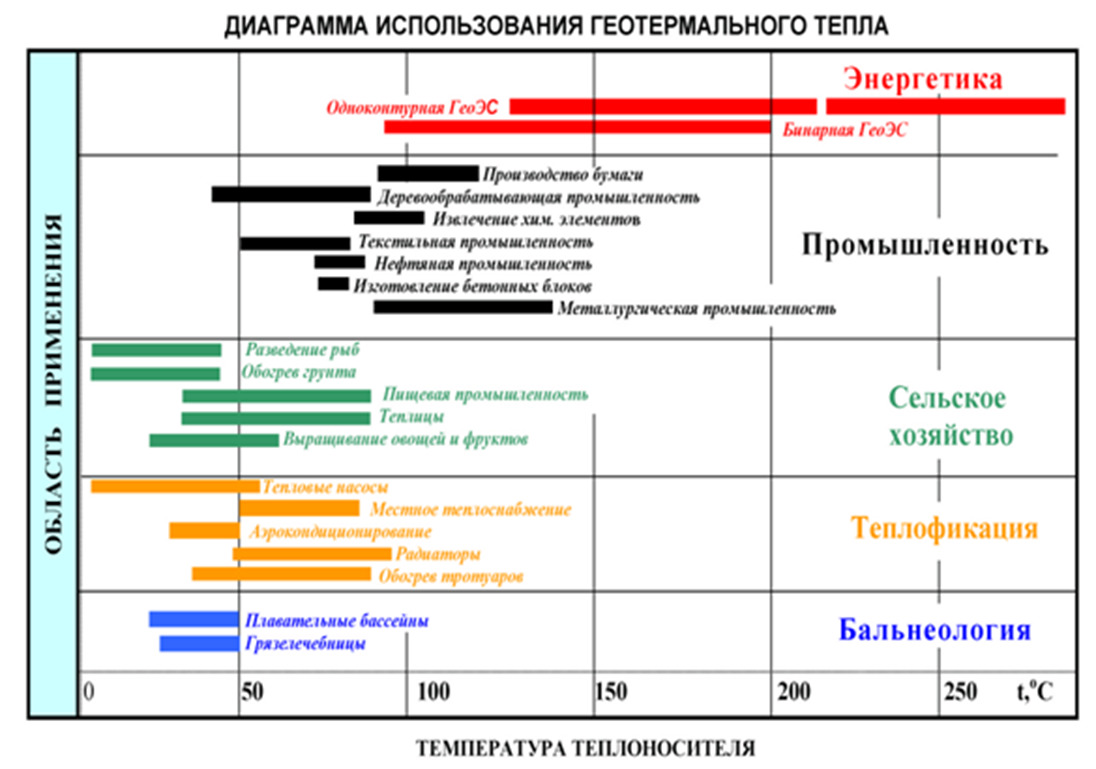
Geothermal energy is widely and successfully used in various sectors of the national economy. There are very broad prospects for expanding the scope of its application:
— heat supply (heating and hot water supply) of civil and industrial buildings and structures;
— heat supply of agricultural facilities (greenhouses and greenhouses of both year—round and seasonal duration, fish-breeding ponds, poultry farms, etc.);
- satisfaction of technological processes of industrial enterprises in heat (drying of wood for furniture production, fermentation of tea leaves, etc.);
— satisfaction of the communal needs of the population (baths, swimming pools, laundries, etc.);
- balneological purposes; electricity generation.
Geothermal resources have several components: they can be considered simultaneously as a source of electrical and thermal energy and as a source of valuable chemical compounds: amorphous silica, B, Li, Zn, Mn, HS, NaCl, geothermal gases H2S, CO2.
Data on the chemical composition of geothermal resources show the presence of geothermal gases (H2S, CO2) in them [4], the control of the concentration of which greatly facilitates their development and the search for new sources of mineral raw materials.
As is known, there are intense absorption lines of geothermal CO2 gases in the range of 1.7—4.8 microns. The development of optoelectronics and its element base, the creation of new highly efficient semiconductor radiation sources create prerequisites for the development of highly sensitive and accurate, reliable devices for monitoring the concentration of geothermal gases (H2S, CO2).
In this paper, a device for monitoring the concentration of geothermal gases is proposed.
The block diagram of an optoelectronic device for monitoring the concentration of geothermal gases is shown in Fig.1, and its time diagrams are shown in Fig.2.
The device for monitoring geothermal gases contains a power source 1, a rectangular pulse generator with two antiphase outputs 2, to one output of which a frequency divider 3 (serial counter) is connected, the output of which is connected via a single-vibrator 4 to the control input of the exponent modulator 5, an emitter repeater 6, two electronic keys 7 and 8, emitting diodes working 9 and the reference 10, emitting at the reference and working wavelengths, respectively, a gas chamber 11, a photodetector 12 connected to the first differentiating device 13, the output of which is through the threshold input of the coincidence circuit 15, the first input of which is connected to the output of the second differentiating device 16, the input of which is connected to the emitting diode 10, the counter 17, the counting input of which is connected to the output of the coincidence circuit 15, and its input "zero setting" is connected to the output of the single-vibrator 4.
The gas chamber 11 is irradiated with two radiation streams F0l1 and F0l2 at the reference l1 and working l2 wavelengths, respectively. The radiation fluxes that have passed through the gas chamber will be equal, respectively:
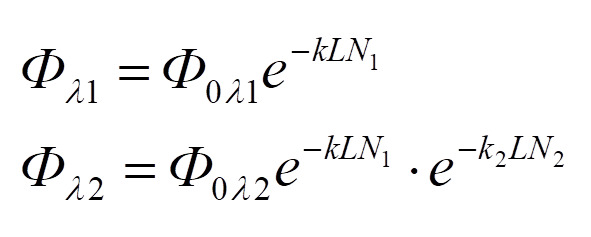
where: F0l1 and F0l1 are radiation fluxes feeding to the gas chamber at wavelengths l1 and l1, respectively, Fl1, Fl2 are radiation fluxes after passing through after passing through the gas chamber at wavelengths l1 and l2, respectively,
N1 — concentration of a mixture of gaseous substances,
L is the length of the optical path, i.e. the length of the gas chamber,
N2 is the concentration of the gaseous substance to be determined,
K1 is the scattering coefficient of a mixture of gaseous substances,
K2 is the absorption coefficient of the determined gaseous substances.
The flow of F0l1 changes in time (t) according to the exponential law
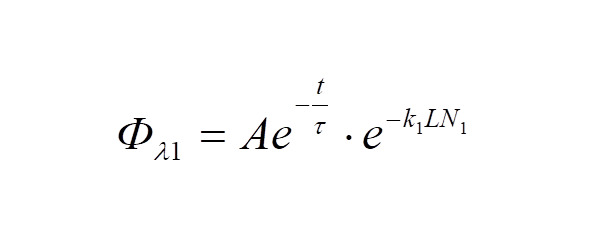
where A is a constant coefficient corresponding to the initial value of the exponential pulse amplitude.
At the moment of equality of flows Al1 and Al2
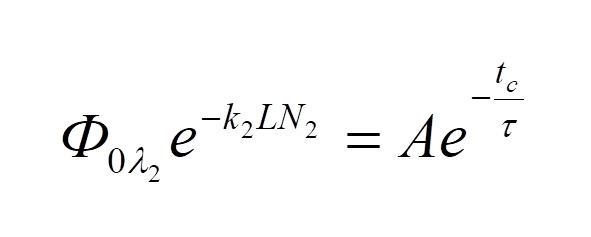
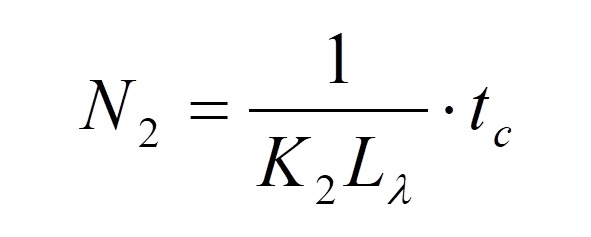
where tc is the time corresponding to the moment of comparison,
t is the time constant of the exponent.
The generator of 2 rectangular pulses generates pulses with the required repetition rate. These pulses from the antiphase outputs go to the input of the frequency divider 3 and to the control inputs of the keys 7 and 8. Rectangular pulses from the output of the frequency divider 3 (Fig.2.a) go to the input of one vibrator 4.
Rectangular pulses with the required duration from the output of one exponent vibrator 5, the output of which is connected via an emitter repeater 6 to the output of an electronic key 8, where a discrete exponential current pulse is formed, which flows through the emitting diode 9, causes a flux emitting according to the same law. The electronic key 7 switches counterphase to the pulses filling the exponent. The current pulse flowing through the emitting diode 10 causes a luminous flux, the amplitude of which is constant. The flows passing through the gas chamber are perceived by the photodetector 12.
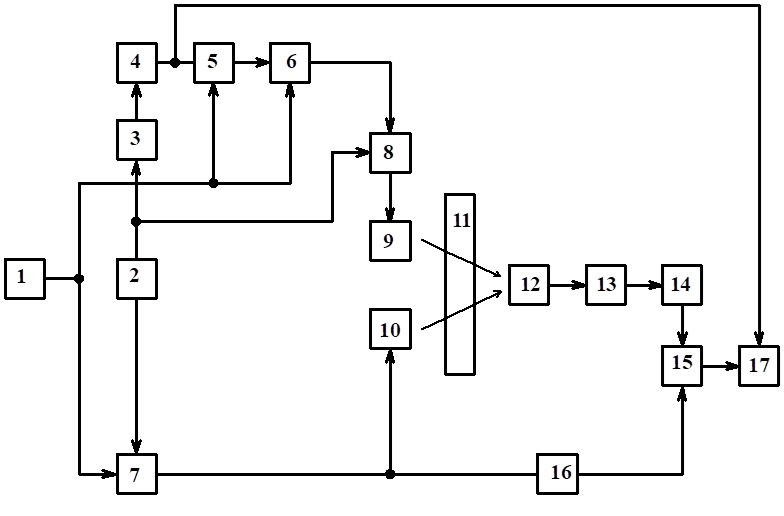
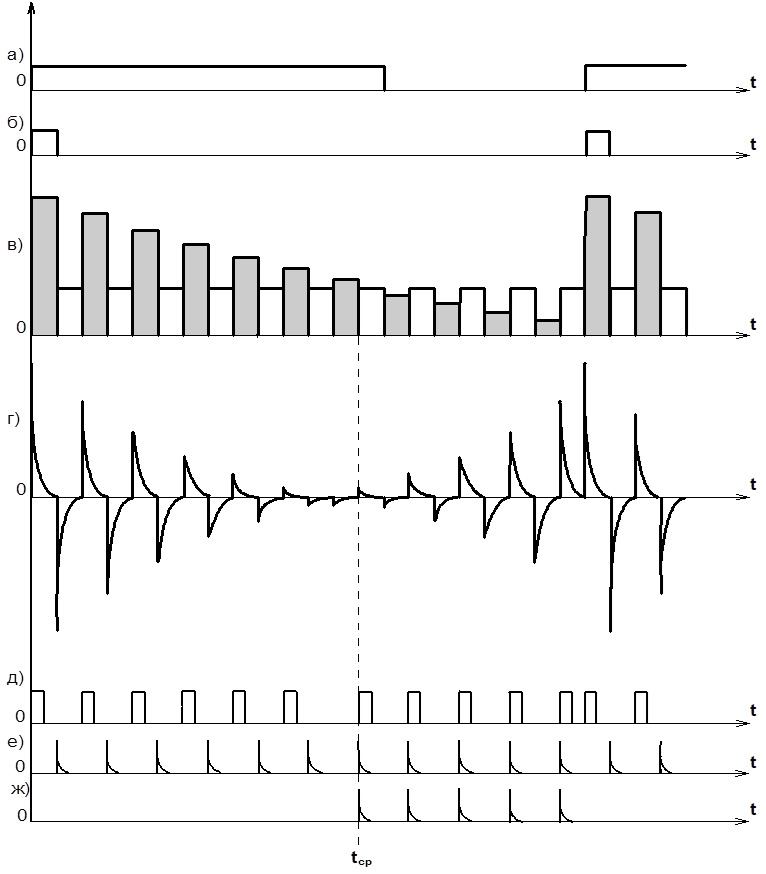
(Fig.2.c) shows a time diagram of the total photoelectric signal at the output of the photodetector 12. This signal is fed to the input of the first differentiating device 13, from the output of which the differentiated photoelectric signal (Fig.2.d) enters the input of the threshold device 14.
Next, the signal from the output of the threshold device 14 (Fig.2.2.d) is fed to one of the inputs of the matching circuit 15. A signal is sent to the other input of the matching circuit 15 from the output of the second differentiating device 16 (Fig.2.e).
From the moment of comparing tc, a series of pulses appears at the output of the coincidence circuit 15, which arrive at the counting input of the counter 17 (Fig.2.2.g).
At the beginning of the next exponent, rectangular pulses from the output of one vibrator 4 arrive at the input "Zero setting" of the counter 17 and the counter 17 is prepared. According to the meter readings, the concentration of CO2 gases can be determined.
The optoelectronic device uses LEDs based on GaAlAsSb/GaInAsSb/GaAlAsSb (3.12 microns) as the emitting diode at the reference wavelength, and LEDs based on GaAlAsSb/GaInAsSb/GaAlAsSb (3.39 microns) as the emitting diode at the measuring wavelength.
A PD36 series photodiode for the spectral range of 1.5—3.8 microns based on the InAs/InAsSbP heterostructure was used in an optoelectronic device for monitoring the CO2 content in the atmosphere.
Literature
1. Avezov R. R., Lutpullaev S. L. The state, prospects and problems of using renewable energy sources in Uzbekistan. // Conference dedicated to the Year of Physics — 2005 Tashkent, September 27 — 28, 2005, p.119.
2.Berman E. Geothermal Energy. Translated from English edited by Dr. B.F. Mavritsky. Mir Publishing House, Moscow. 1978. — 167s.
3. Alkhasov A. B. Geothermal energy: problems, resources, technologies. M.: Fizmatlit, 2008. 376 p.
4. Processes of heat and mass transfer in the complex use of geothermal resourses: Monograph / V. V. Potapov, M. A. Bliznyukov, S. A. Smyvalov, V. A. Gorbach. — Petropavlovsk-Kamchatsky: Kamchatstu, 2005. — 136 p.
HUMIDITY METER ON SEMICONDUCTOR EMITTERS
UDC 621.38
Qo’ldashov Obbozjon Xokimovich
Doctor of Technical Sciences, Professor of the Scientific Research Institute «Physics of Semiconductors and Microelectronics» at the National University of Uzbekistan
Sayfullaev Xamidullo Turg'unbay ugli, Boltaboev Javohir Jakhongir o'g'li
2nd year masters of the Department of «Physics of Semiconductors and Polymers» of the Faculty of Physics of the Mirzo Ulugbek National University of Uzbekistan
Scientific Research Institute "Physics of Semiconductors and Microelectronics" at the National University of Uzbekistan
Annotation. The article proposes a humidity meter based on semiconductor emitters. The spectral characteristics of humidity and LED are given. A block diagram of a humidity meter on semiconductor emitters is given.
In the humidity meter on semiconductor emitters, LEDs based on GaAlAsSb/GaInAsSb/GaAlAsSb (2.2 microns) are used as a emitting diode at the reference wavelength, and LEDs based on GaAlAsSb/GaInAsSb/GaAlAsSb (1.94 microns) are used as a emitting diode at the measuring wavelength.
Keywords: optoelectronics, spectra, absorption, LEDs, photodiodes, device, mathematical model, block diagram, microprocessor unit.
Аннотация. В статье предложен измеритель влажности на полупроводниковых излучателях. Приведены спектральные характеристики влажности и светодиода. Приведена блок схема измерителя влажности на полупроводниковых излучателях.
В измерителе влажности на полупроводниковых излучателях использованы в качестве излучающего диода на опорной длине волне светодиоды на основе GaAlAsSb/GaInAsSb/GaAlAsSb (2.2 мкм), а излучающего диода на измерительной длине волны светодиоды на основе GaAlAsSb/GaInAsSb/GaAlAsSb (1.94 мкм).
Ключевые слова: оптоэлектроника, спектры, поглощение, светодиоды, фотодиоды, устройство, математическая модель, блок схема, микропроцессорный блок.
Introduction
The basis of optoelectronic methods and devices are emitters and photodetectors. The widespread use of optoelectronic methods was hindered by the lack of simple reliable radiation sources. The appearance of semiconductor radiation sources has significantly expanded the scope of application of optoelectronic methods and devices [1].
At present, semiconductor emitters with a radiation spectrum ranging from the ultraviolet section to the near infrared section of the optical spectrum have been developed and are being mass-produced. Practically at present, it is possible to develop emitters in the range from 210 to 4000 microns with spectral characteristics close to monochromatic (with quasi-monochromatic spectral characteristics). The features of semiconductor emitters are high speed, the ability to control the radiation flow by current, monochromaticity, sufficient radiation power and small overall dimensions. The presence of such advantages in semiconductor emitters creates prerequisites for the research and development of various monitoring, measurement and conversion devices for various fields of science and technology. Hence follows a wide range of work in the field of creating devices and systems based on semiconductor emitters [2].
The basis of optical methods and devices is the presence of an emitter and an optically connected photodetector through the medium. The radiation generated by the emitter, passing through the medium (air, substance, etc.), is perceived by the photodetector. In these methods and devices, optical radiation is used as a data carrier that does not create electromagnetic interference and is not affected by these interference. The presence of such a feature and the simplicity of the instrument implementation create prerequisites for the research and development of various devices based on the use of optical radiation [3].
The main part
To build a moisture meter on semiconductor emitters, the property of water to absorb IR radiation of a certain wavelength is important [4]. All substances and materials have a certain hygroscopicity and, therefore, absorb moisture from the external environment. The analysis of spectral characteristics showed that the absorption bands lie in the range of 0.76...0.97 and 1.19...1.94 microns [5].
Table 1 shows the absorption spectra of water and their affiliation.
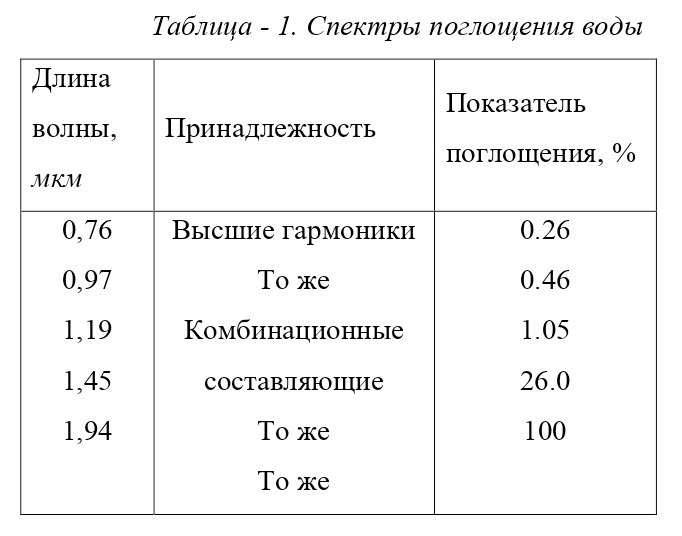
From the different spectral characteristics of dry matter (Fig. 1, curve 1) and at a humidity of 9% H2O (curve 2), it follows that at a wavelength of 1.94 microns, water has significant absorption [6]. In the humidity meter on semiconductor emitters, LEDs with radiation spectra of 2.2 microns are used as a reference channel, and LEDs with radiation spectra of 1.94 microns are used as a measuring channel).
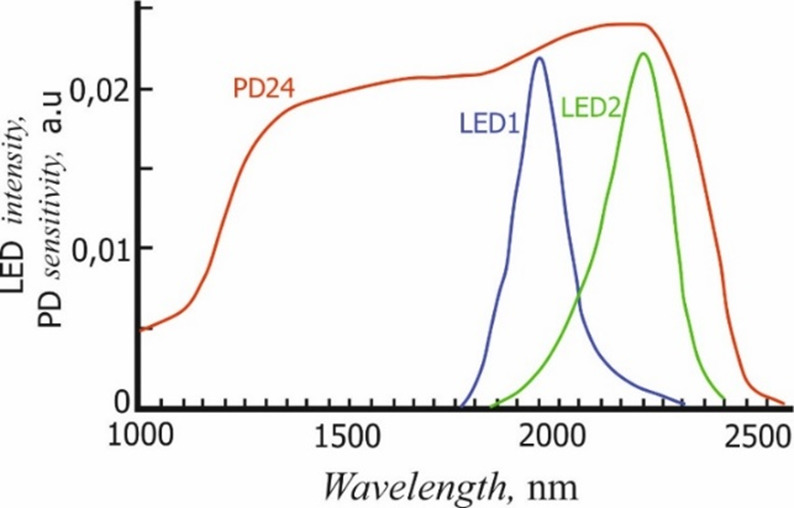
LEDs based on the semiconductor compound GaSb and its solid solutions GaInAsSb and AlGaAsSb have been developed to measure the moisture content of raw cotton. LED structures are manufactured by the FEF method and grown on Gaas n-type conductivity substrates doped with Te to an electron concentration of 8·1017 cm-3. The emitters for measuring the moisture content of raw cotton consisted of an active layer of n — GaInAsSb (Eg = 0.51 eV) 2—3 microns thick and grown on n — GaSb substrates and doped with Te to a charge carrier concentration of 9·1017 cm—3, the wide-band emitter p — AlGaAsSb, doped with germanium to a concentration of 5·1018 cm-3 (fig.2).
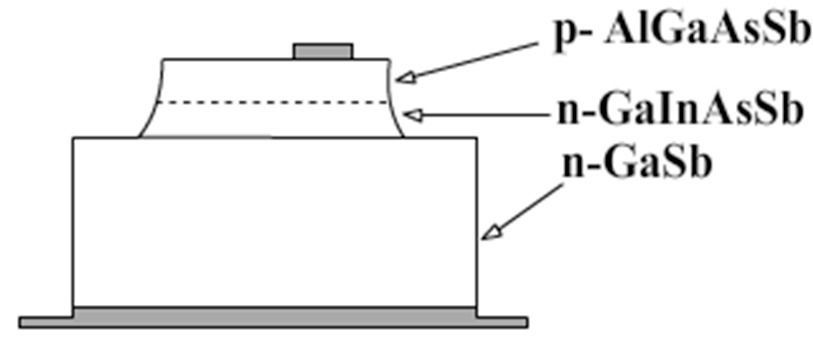
LEDs based on the GaSb semiconductor compound for measuring the humidity of raw cotton at a temperature of 24 0C had an external quantum photon output of 5.9 — 6.5% and an optical power of 3.9 MW in direct current.
To maximize the output of optical radiation, the TO-18 housing with a parabolic reflector is used, which allows collimating radiation at an angle of 10—11o. Figure 3 shows the design of the IR LED:
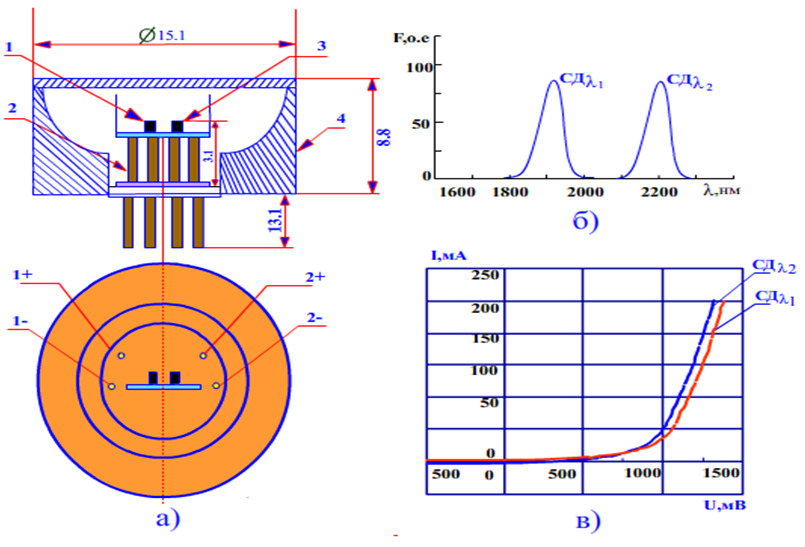
LEDs based on the GaAlAsSb/GaInAsSb/ GaAlAsSb double heterostructure had a quantum yield of 5.8%, a radiation wavelength of 1.94 microns for measuring the moisture content of raw cotton, its main parameters are shown in Table 2.
The proposed design provides equal conditions for two LED crystals, thus eliminating the time and temperature instabilities of their main parameters.
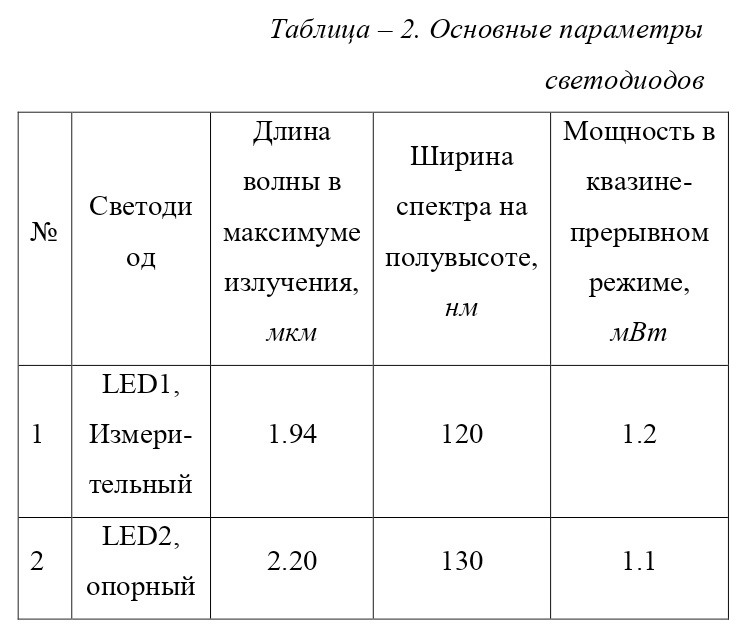
Fig. 3 shows a block diagram of a digital humidity meter, which consists of the following elements: a master generator — ZG; trigger — T; frequency divider — DC; differentiating devices — DU1, DU2; exponent modulator — ME; emitter repeater — EP; pulse amplifier — IU; radiation receiver — AF; low — noise amplifier — MSU; matching circuit — SS; counter — SCH; decoder — DS; indicator — IN; reference LED — ID1; measuring LED — ID2.

The characteristic features of the humidity meter on semiconductor emitters are high selectivity, sensitivity, accuracy and reproducibility of measurements, as well as the possibility of continuous non-destructive testing, contactless and rapid analysis.
Conclusion
To create a humidity meter on semiconductor emitters, the optimal absorption band free from the absorption band of interfering components l1 = 1.94 microns has been determined.
The optoelectronic device uses LEDs based on GaAlAsSb/GaInAsSb/GaAlAsSb (2.2 microns) as the emitting diode at the reference wavelength, and LEDs based on GaAlAsSb/GaInAsSb/GaAlAsSb (1.94 microns) as the emitting diode at the measuring wavelength.
The absolute error of the moisture content measurement results was 0.5%.
Literature
1. Bashkatov A. S., Mescherova D. N. «The main trends in the development of optoelectronic technology until 2030,» Abstracts of the Russian Conference and School of Young scientists on current problems of semiconductor photoelectronics «Photonics-2019», 2019, doi: 10.34077/rcsp2019—25. pp.25—26.
2. Bogdanovich M. V. «Water content meter in oil and petroleum products based on infrared optoelectronic LED-photodiode pairs,» Journal of Technical Physics, 2017, doi:10.21883/jtf.2017.02.44146.1791.
3. Masharipov Sh. M. Analysis of modern methods and technical means of measuring humidity of cotton materials. // Devices, 2016, No. 4., pp. 31—37.
4. Demyanchenko M. A. Absorption of infrared radiation in a multilayer bolometric structure with a thin metal absorber // Optical Journal. — 2017. Volume 84 — pp. 48—56.
5. Rakovics V., Imenkov A. N., Sherstnev V. V., Serebrennikova O. Yu., Ilyinskaya N. D., Yakovlev Yu. P. «Powerful LEDs based on InGaAsP/InP heterostructures,» fiz. i tekhnika poluprovodn., 2014.t.48.s.1693—1697.
6. Artemov V. G., Volkov A. A., Sysoev N. N. «The absorption spectrum of water as a reflection of charge diffusion // Izvestia of the Russian Academy of Sciences. Physical series, Proceedings of the Russian Academy of Sciences. The series is physical. — 2018. — vol.82. — pp. 67—71. doi: 10.7868/s0367676518010143.
DEVICES FOR REMOTE TEMPERATURE CONTROL BASED ON LEDS (λ=2.0 microns)
UDC 621.38
Qo’ldashov Obbozjon Xakimovich
Doctor of Technical Sciences, Professor of the Scientific Research Institute "Physics of Semiconductors and Microelectronics" at the National University of Uzbekistan
Ergashev Doniyor Jamoliddin ugli
2nd year Master of the Department of "Physics of Semiconductors and Polymers" of the Faculty of Physics of the Mirzo Ulugbek National University of Uzbekistan
Scientific Research Institute "Physics of Semiconductors and Microelectronics" at the National University of Uzbekistan
Annotation. An optoelectronic device for remote temperature control of small-sized objects is proposed, which can be successfully used in the study of temperature characteristics of solar installations.
Keywords: temperature, optoelectronics, sensor, control, LED, photodiode, block diagram, design.
Аннотация. Предложено оптоэлектронное устройство для дистанционного контроля температуры малоразмерных объектов, которое может быть успешно использовано при исследовании температурных характеристик гелиотехнических установок.
Ключевые слова: температура, оптоэлектроника, датчик, контроль, светодиод, фотодиод, блок схема, конструкция.
The device for remote temperature control contains a monitoring object 1, which through a modulator 2 is optically connected to the first radiation receiver 3, whose output is through the first amplifier 4, the first amplitude detector 5 and the first integrator 6, connected to the first input of the signal ratio receiving device 13, the second radiation receiver 7, whose output is through the second amplifier 8, the second amplitude detector 9 and the second integrator 10 are connected to the second input of the signal ratio receiving device 13 whose output is connected to the input of the recording device 14, the control device of the source of the collimated radiation 12, the input of which is connected to the output of the first amplifier 4, and the output is connected to the input of the source of the collimated radiation 11, which, through reflection from the surface of the controlled object 1, is optically connected to the second radiation receiver 7, an electric motor 15, the rotor of which is mechanically connected to the axis of rotation of the modulator 2. In Fig.4.13. the design of the modulator is shown. Here: 16 is the axis of rotation of the modulator; 17 is the modulating holes; 18 is a metal disk. Figure 4.14 shows time diagrams explaining the principle of operation of the proposed device. Figure 1 shows a block diagram, and Figure 2 shows the sensor design.
The optoelectronic device works as follows. The thermal radiation flux FPI1 (λ) of the control object 1, which is proportional to its temperature, passes the distance l, is modulated by the modulator 2 and enters the sensitive area of the first radiation receiver. The flux reaching the sensitive area of the first radiation receiver, according to the theory of optoelectronic devices, is defined as:
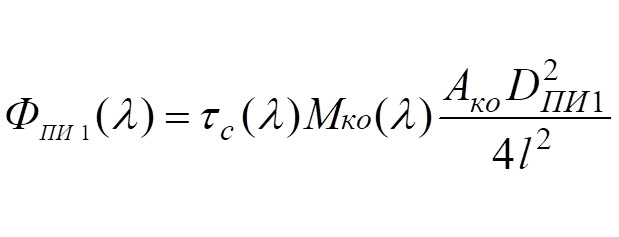
where: tc (λ) is the spectral transmittance of the atmosphere; Mco (λ) is the spectral density of the energy luminosity radiating from the surface of the controlled object; Ako is the area of the radiating surface of the controlled object; DP1 is the diameter of the entrance pupil of the first radiation receiver; l is the distance between the controlled object and the first photodetector.
Table 1 shows the main characteristics of photodiodes
Considering that
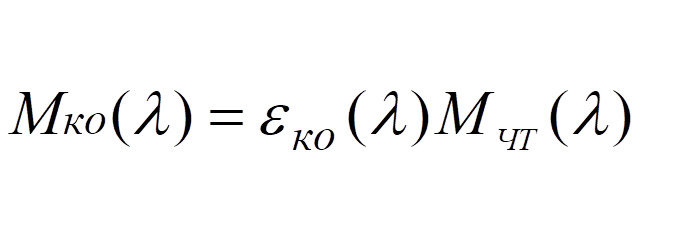
expressions (1) will take the form:
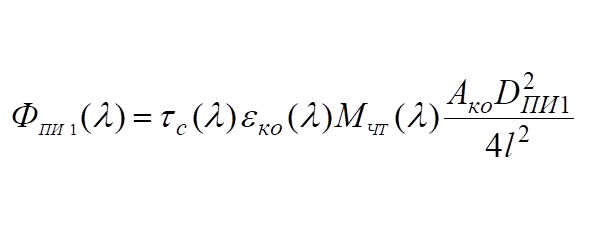
where: eko (λ) is the spectral coefficient of thermal radiation of the controlled object; MCHT (λ) is the spectral density of the energy luminosity of the black body. Considering that the radiation receiver operates in a limited spectral range, expression (2) for wavelengths λ1m, which corresponds to the maximum sensitivity of the first radiation receiver, can be written as:
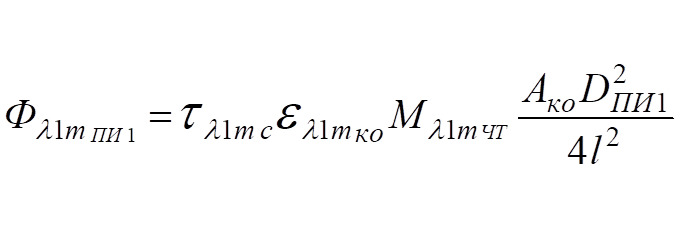
where: ελ1mk0 is the spectral coefficient of thermal radiation of the controlled object at wavelengths λ1m; Mλ1mcht is the spectral density of the energy luminosity of the black body at wavelengths λ1m; τλ1mc is the transmittance of the atmosphere at wavelengths λ1m.
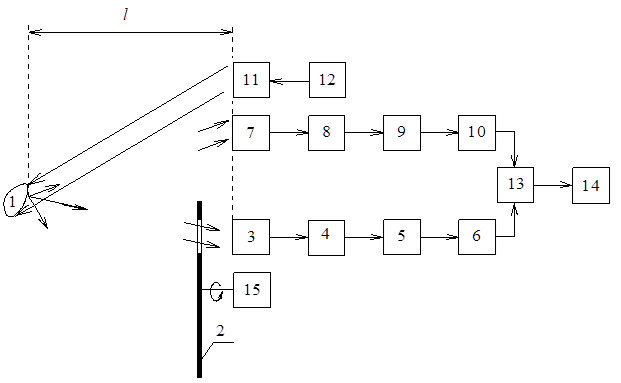
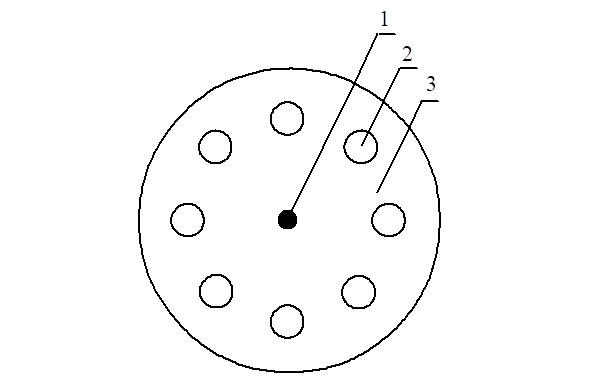
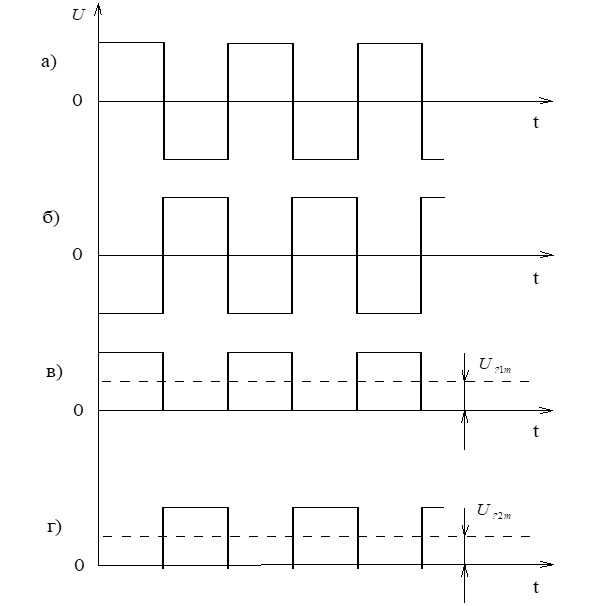
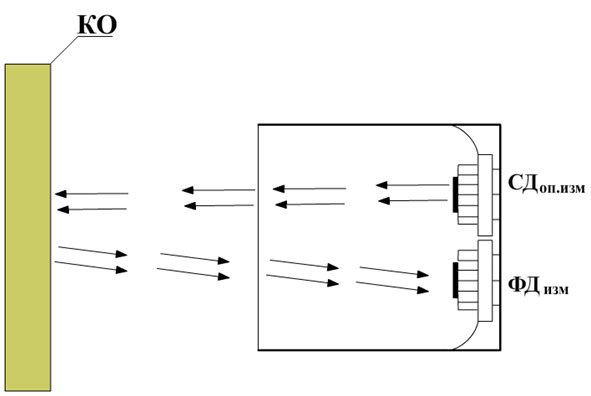
Taking into account the Stefan-Boltzmann law that Mλ1mcht=σT4, expression (4) will take the form:
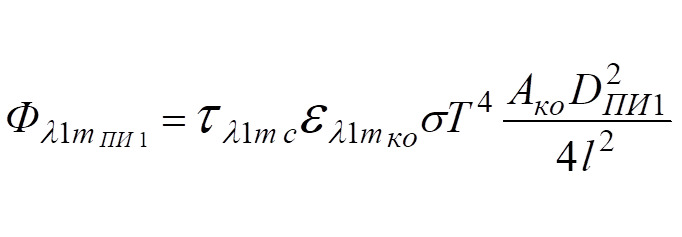
where: T is the temperature of the controlled object; σ=5.6697*10-8 W*m-2*K-4 is the Stefan-Boltzmann constant.
In addition, the sensitive area of the first radiation receiver 3 is affected by the heat flux of radiation from the modulator 2, which can be described by the ratio
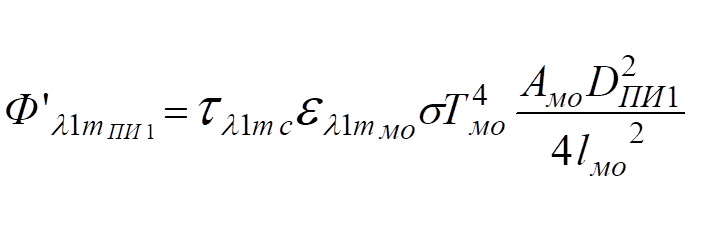
where: ελ1mm0 is the spectral coefficient of thermal radiation of the modulator at wavelengths λ1m; Tmo is the temperature of the modulator; Amo is the area of the radiated surface of the modulator; lmo is the distance between the modulator and the first radiation receiver.
Therefore, the total flux acting on the sensitive area of the first radiation receiver has the form.
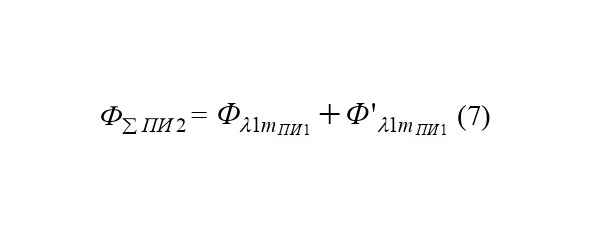
Then the output voltage of the first radiation receiver is defined as:
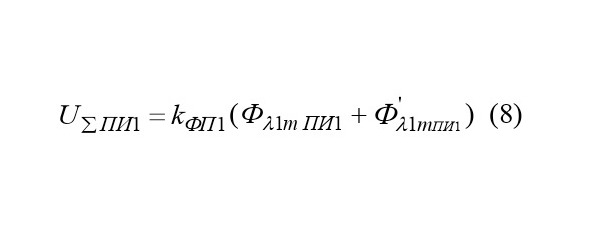
or
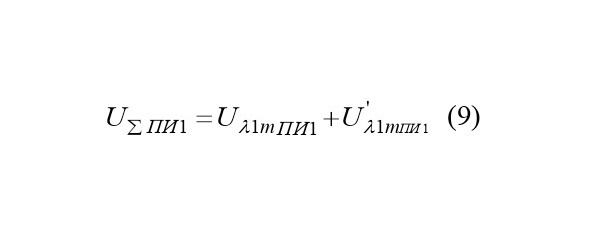
where: is the transmission coefficient of the first radiation receiver.
The voltage corresponding to expression (9) from the output of the second radiation receiver 3 is amplified by the first amplifier 4, as a result of which an alternating electrical signal is formed at its output (see Fig. 3.c) the amplitude of which is defined as:
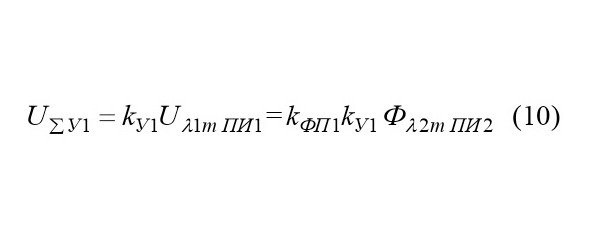
where ky1 is the transmission coefficient of the first amplifier 4.
Since due to the use of a disk modulator with symmetrical modulating holes, the thermal radiation of the modulator itself, which affects the sensitive area of the first radiation receiver during the modulation period remains constant (see Figure 3a), i.e.
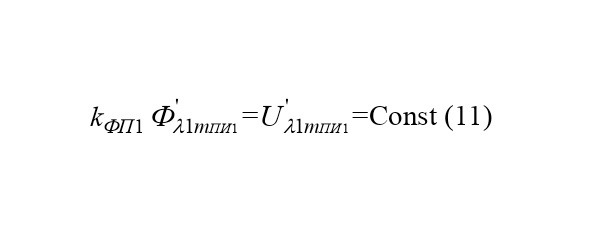
Therefore, the constant component of the total signal of the first radiation receiver 3 does not pass through the AC amplifier 4. That is, the amplitude of the variable component of the amplified signal is proportional only to the amplitude of the flux Fλ1mPI1.
The variable component of the amplified signal is detected by the first amplitude detector 5. The detected signal (see Figure 3.d) from the output of the first amplitude detector 5 is integrated by the first integrator 6 and fed to the first input of the signal ratio device 13.
In this case, the voltage supplied to the first input of the signal ratio receiving device 13, taking into account the above, can be described by the expression:
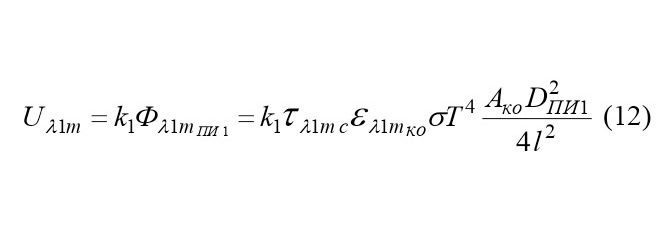
where k1=kPI1kU1kAD1kINT1 is the total transmission coefficient of blocks connected in series with the first radiation receiver 3, the first amplifier 4, the first amplitude detector 5 and the first integrator 6; kAD1 is the transmission coefficient of the first amplitude detector; kINT1 is the transmission coefficient of the first integrator.
When the output signal of the first amplifier 4 is exposed to the input of the control device of the collimated radiation source 12, an antiphase electrical signal is formed at its output. The latter is fed to the input of the collimated radiation source 11 and causes a pulsed flow of collimated radiation at its output.
The formed flow, by the source of collimated radiation 11, is induced to the area of the controlled object 1. In this case, the flow reaching the surface of the controlled object 1 in the case Ako ≤ Aki is defined as:
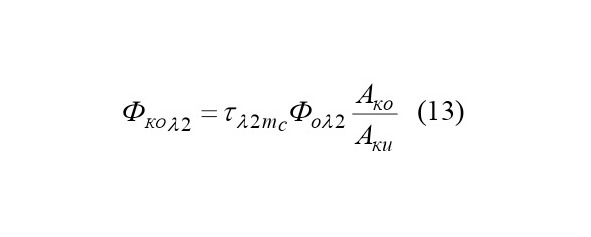
where Aki is the cross — sectional area of collimated radiation; τλ2mc is the transmittance of the atmosphere at wavelengths λ2m; Foλ2 is the initial flux of collimated radiation. In this case, the reflected flow from the surface of the controlled object 1 is defined as:
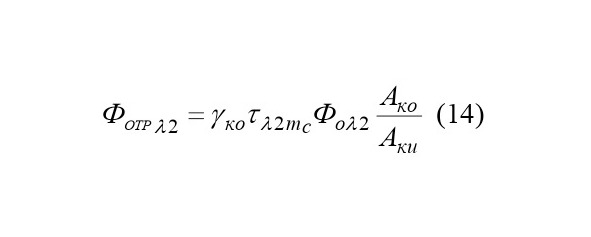
where uco is the reflection coefficient of the surface of the controlled object at wavelengths λ2.
In this case, the expression for the reflected modulated flux from the surface of the controlled object and reaching the sensitive area of the second radiation receiver 7 has the form:
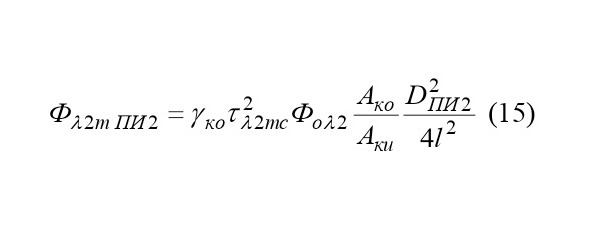
where: DPI2 is the diameter of the entrance pupil of the second radiation receiver.
In addition, in the case of a partial coincidence of the radiation spectrum of the controlled object with the spectral sensitivity of the second radiation receiver 7, an unmodulated radiation flux from the controlled object at a wavelength of λ2m affects the sensitive area of the latter.
Бесплатный фрагмент закончился.
Купите книгу, чтобы продолжить чтение.